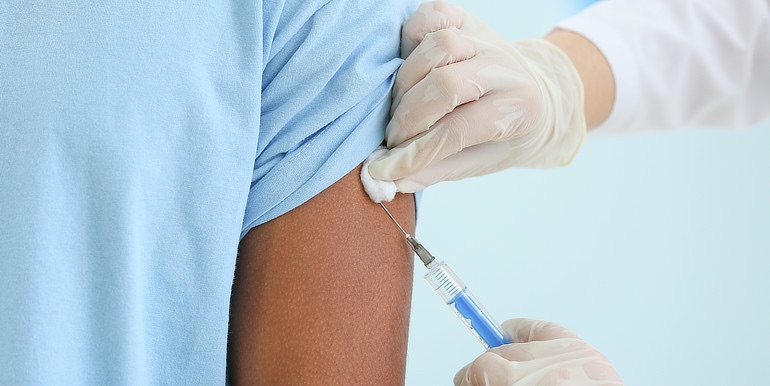Studies reveal potential HPV vaccine to substantially reduce incidence of cervical cancer and suggest screening programmes could be modified
09. 11. 2011 | ecancer.org
The bivalent human papillomavirus (HPV) vaccine (Cervarix, GlaxoSmithKline) offers excellent protection against the more serious immediate precursor to invasive cervical cancer (ICC), particularly when given to young adolescent girls before they become sexually active. The findings of two studies published in The Lancet Oncology, also show that the vaccine partially protects against four other cancer-causing HPV types not targeted by the formulation, that together with HPV16/18, cause about 85% of cervical cancer worldwide.

Image credit: depositphotos.com
"Provided that organised vaccination programmes achieve high coverage in early adolescents before sexual debut, HPV vaccination has the potential to substantially reduce the incidence of cervical cancer, probably allowing modification of screening programmes... when conducted alongside vaccination strategies", explains one of the lead authors, Matti Lehtinen from the University of Tampere in Finland.
The bivalent vaccine targets HPV types 16 and 18 that are responsible for about 70% of cervical cancers. Most studies of vaccine efficacy have focused on prevention of cervical intraepithelial neoplasia 2 (CIN2) or higher. However, CIN3 is generally believed to be a more reproducible and predictive endpoint than CIN2, and often progresses to ICC.
In 2009, the PApilloma TRIal against Cancer In young Adults (PATRICIA), the largest study of HPV16/18 vaccine efficacy to date, reported that the bivalent vaccine had high efficacy against the precancerous cervical lesions CIN2+.
The study included almost 20 000 healthy women aged 15–25 years from 14 countries in Asia-Pacific, Europe, Latin America, and North America. Women were randomly assigned to receive the bivalent HPV vaccine or a control (hepatitis A) vaccine, given in three doses at enrolment, 1 month, and 6 months.
Here, the researchers report the final analysis (after 4 years of follow-up) that examined the efficacy of the vaccine against high-grade cervical precancers (CIN3+), the early development of adenocarcinoma (AIS), and 12 other cancer-causing HPV types not targeted by the vaccine.
In young women not already infected with HPV, the vaccine proved over 93% effective against CIN3+ and prevented 100% of AIS regardless of HPV type compared with nearly 46% efficacy against CIN3+ and 77% against AIS in the general population of women. Amongst the previously unexposed young women, the vaccine prevented 100% of HPV16/18-related CIN3+, compared with nearly 46% in the general population regardless of prior exposure to HPV.
The authors conclude: "Appropriate effectiveness and implementation studies assessing the combination of vaccination and new screening strategies are warranted."
In a second study, the vaccine showed increased cross-protection against other cancer-causing HPV types 31, 33, 45, and 51 in different cohorts representing diverse groups of women.
"There is a particularly high risk of HPV-33 infections progressing to cervical lesions, and HPV-45 is over-represented in adenocarcinoma...Our results show that cross-protective efficacy might provide substantial additional protection against cervical cancer beyond protection conferred against HPV-16/18", concludes Cosette Wheeler from the University of New Mexico Health Sciences Center, Department of Pathology, in the USA, one of the lead authors of the study.
In a Comment, Mark Schiffman and Sholom Wacholder from the National Cancer Institute, Rockville, MD, USA remark: "We believe that increasing coverage, particularly of sexually-naïve adolescent females, is now the most important public-health issue in HPV vaccination efforts."
They add: "We are particularly concerned about low vaccination rates in areas where cervical cancer incidence and mortality are high because of inadequate alternative prevention through effective cervical screening, and where nine of 10 cervical cancers deaths occur...The current vaccines are too expensive and difficult to deliver for many low-resource regions."
Read the whole article at ecancermedicalscience
Reference
- Lehtinen M, Paavonen J, et al. Overall efficacy of HPV-16/18 AS04-adjuvanted vaccine against grade 3 or greater cervical intraepithelial neoplasia: 4-year end-of-study analysis of the randomised, double-blind PATRICIA trial. The Lancet Oncology 2011. doi: 10.1016/S1470-2045(11)70286-8
- Wheeler C, Castellsague X, et al. Cross-protective efficacy of HPV-16/18 AS04-adjuvanted vaccine against cervical infection and precancer caused by non-vaccine oncogenic HPV types: 4-year end-of-study analysis of the randomised, double-blind PATRICIA trial. The Lancet Oncology 2011. doi: 10.1016/S1470-2045(11)70287-X
Keywords: HPV vaccine, invasive cervical cancer, vaccination programmes, cervical cancer screening



